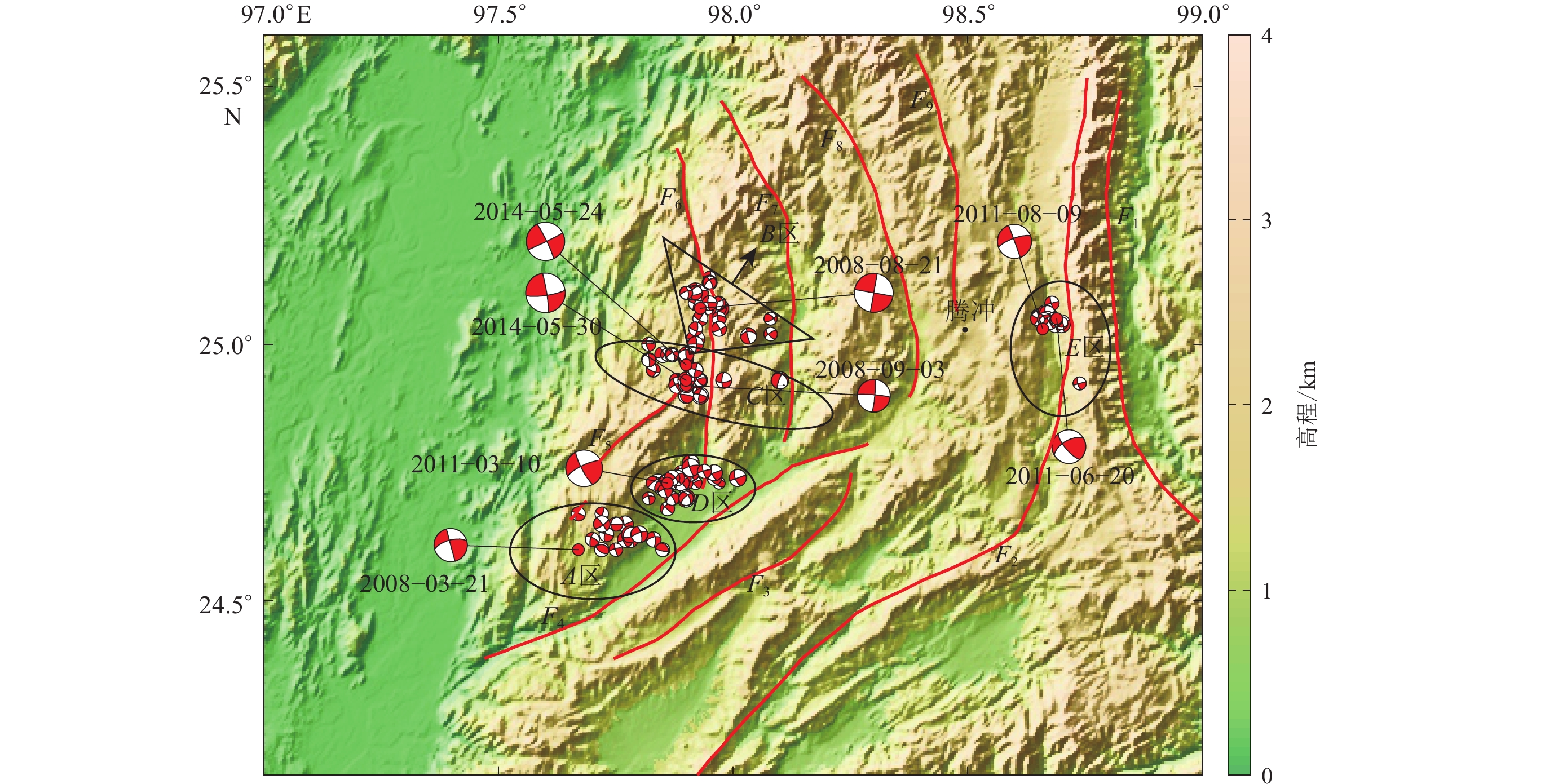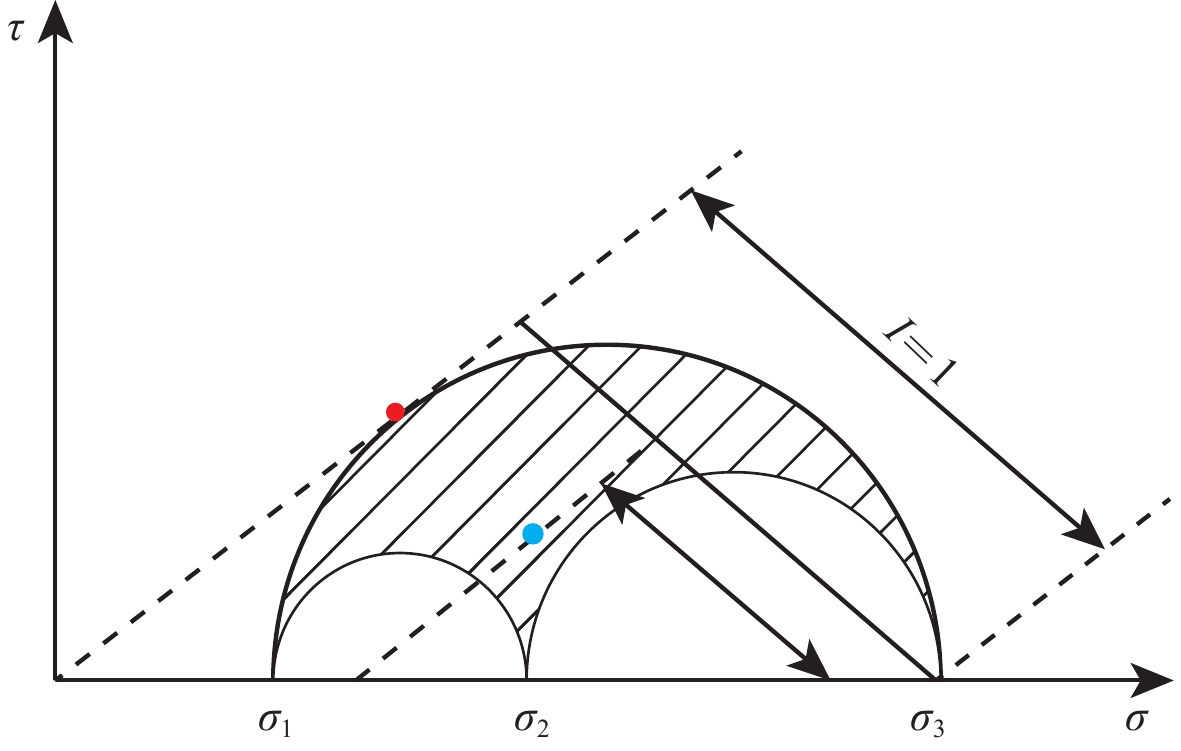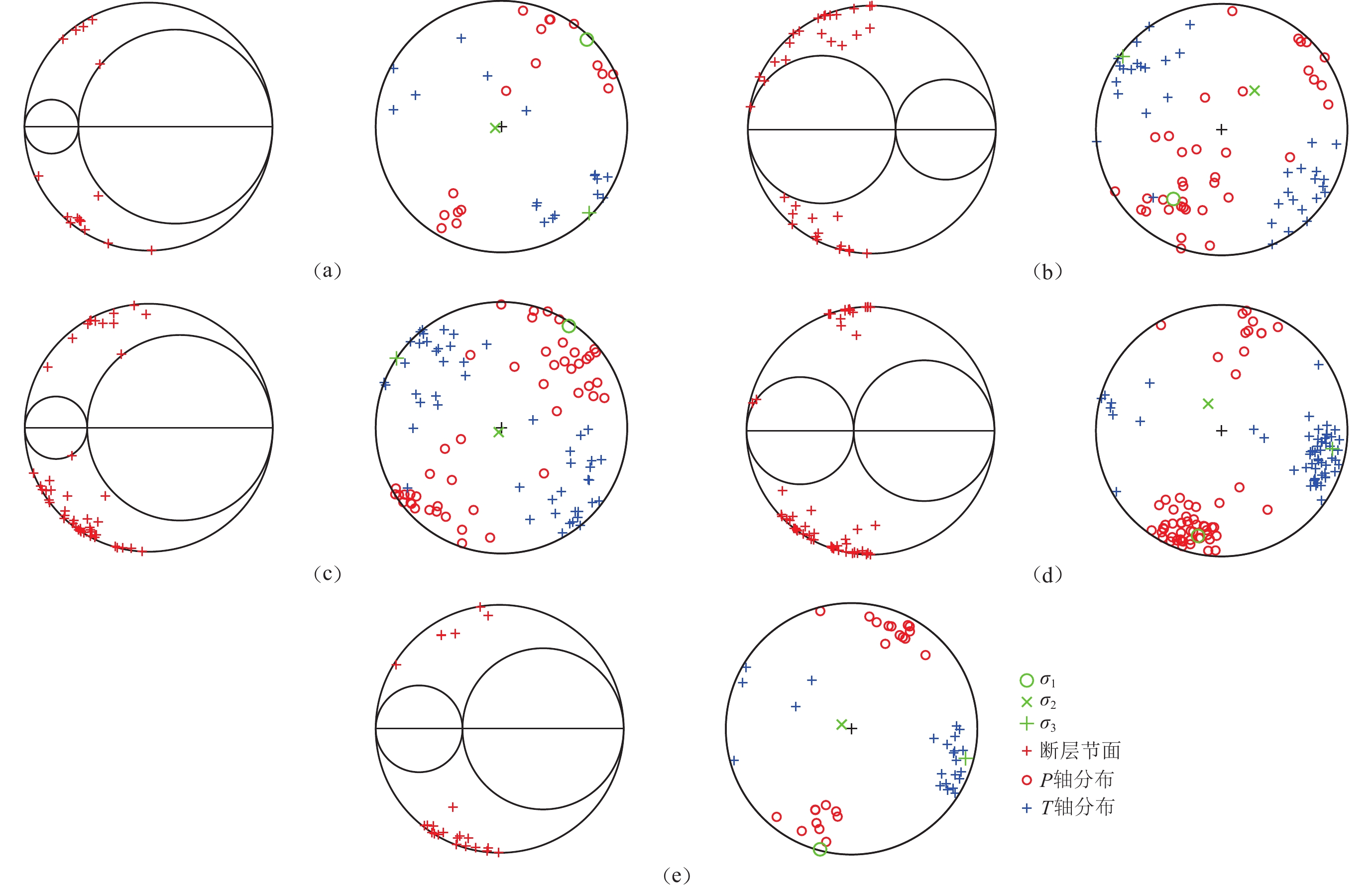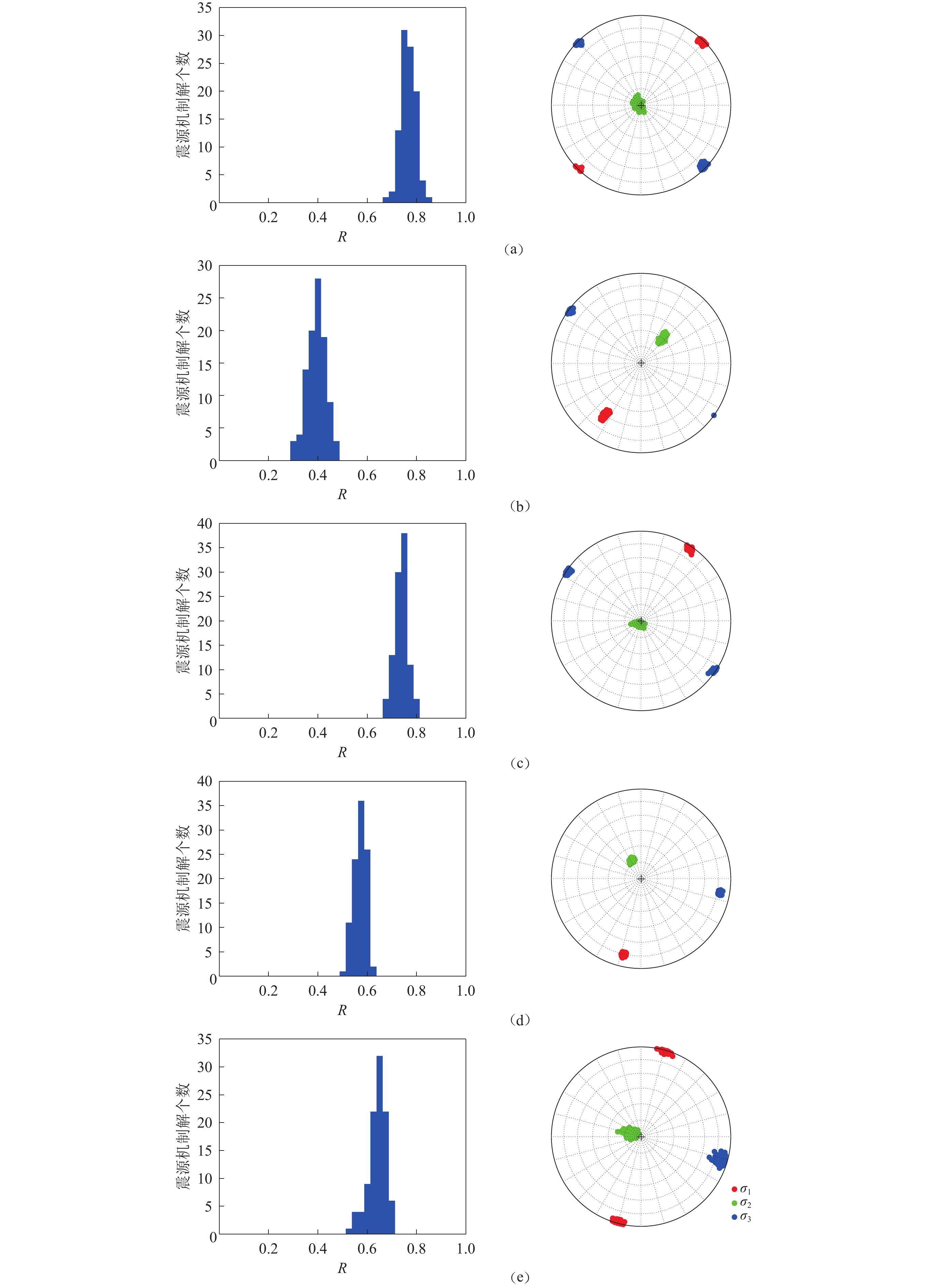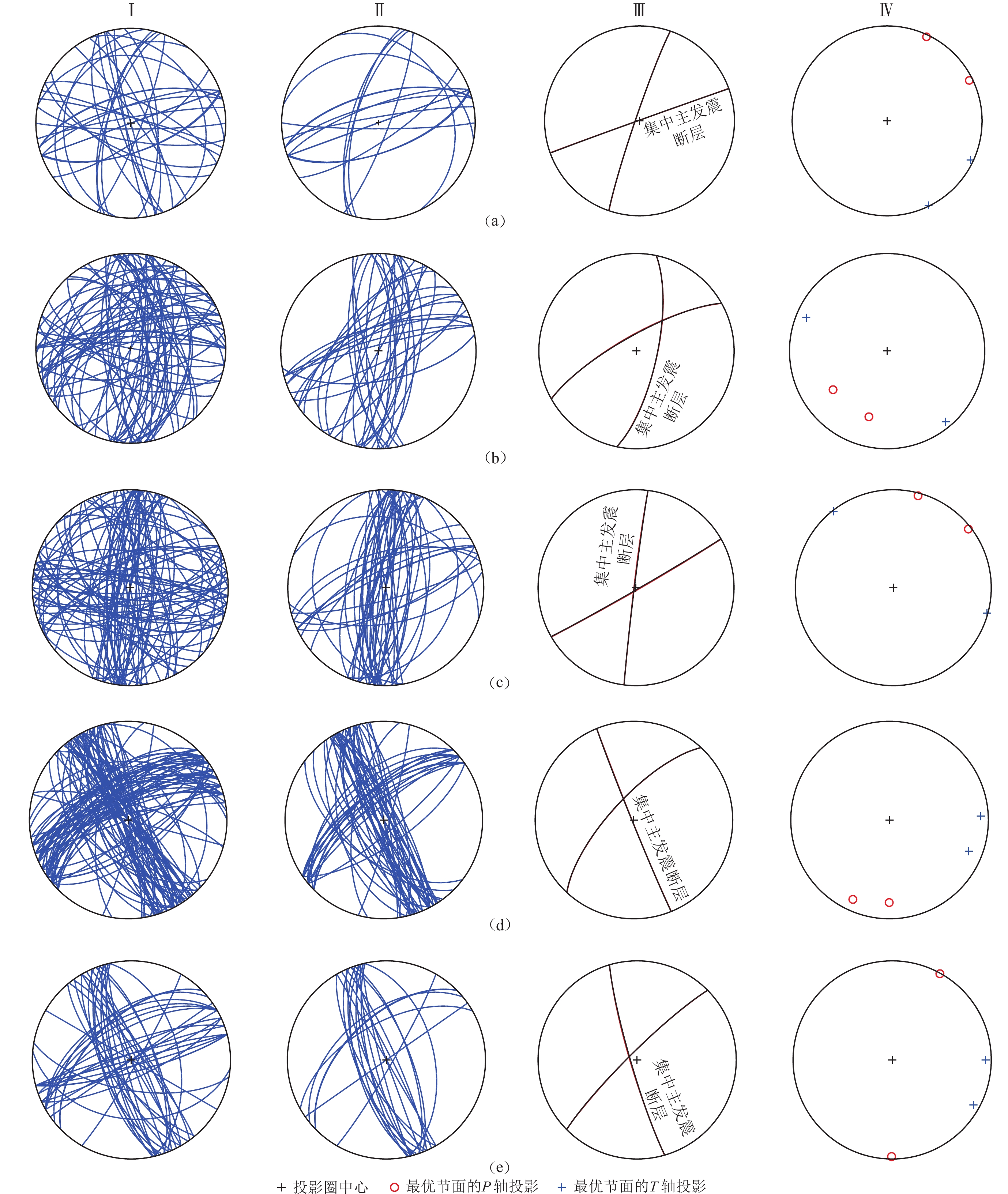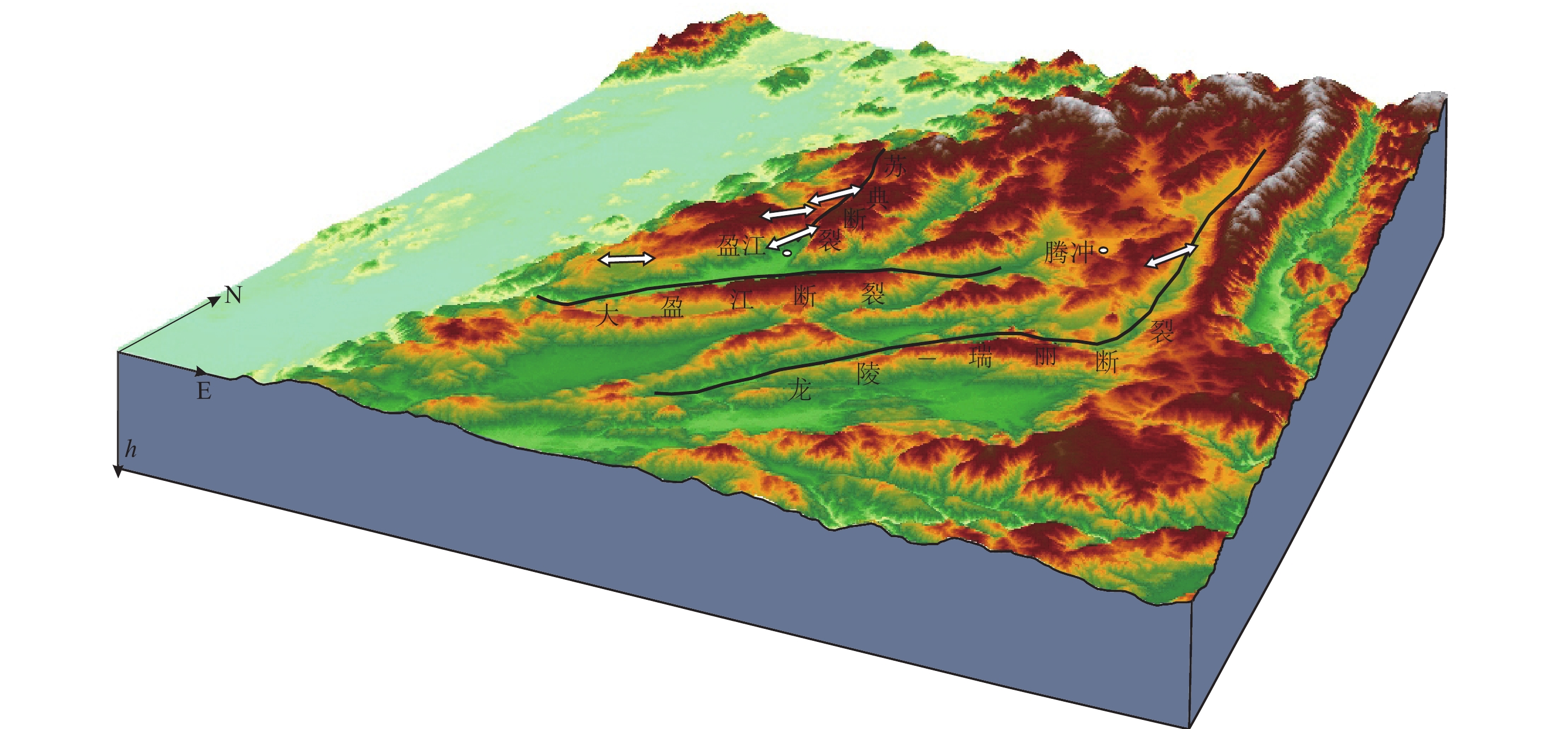Joint iterative inversion of tectonic stress field and fault identification in Yingjiang area
-
摘要: 搜集了盈江及其邻区5组地震序列震源机制解并反演得到该区域的构造应力场。研究结果显示:盈江地区整体主压应力以NNE向为主,主张应力以ESE向为主;但其局部应力场不完全一致,沿苏典断裂分布的主压应力轴走向随着断裂走向由北向南延伸角度逐渐向北偏移,而盈江地区的西南部,其主压应力走向更偏向于东,这可能与大盈江断裂的横向拉伸有关。此外,本研究通过应力场反演识别出了5组地震序列震源机制解的主发震断层节面的走向、倾角、滑动角及发震断层的摩擦系数,为今后该区域的地震研究及地壳动力学变迁提供了参考。Abstract: There has always been a problem in inversion of tectonic stress field by focal mechanism solution, it is impossible to determine which nodel plane is the correct seismogenic fault plane. The joint iterative stress inversion method can effectively avoid the error caused by incorrect fault selection by identifying the fault instability. In this paper, the focal mechanism solutions of five groups of earthquake sequences in Yingjiang and its adjacent areas are collected, and the tectonic stress field in this area is inversed. The results show that, in Yingjiang area, the main compressive stress is NNE, and the main tensile stress is ESE, which is basically consistent with the previous research results. However, the local stress field is not completely consistent. The strike of the principal stress axis along the Sudian fault extends from north to south, and the angle gradually shifts to the north. In the southwest of Yingjiang, the strike of the principal stress tends to the East, which may be related to the transverse extension of the Dayingjiang fault. In addition, the strike, dip angle, slip angle and friction coefficient of the main seismogenic fault nodal planes of the focal mechanism solutions of five groups of earthquake sequences are identified by stress field inversion. This provides a valuable reference for the future seismic and crustal dynamic changes research in this region.
-
引言
鲜水河断裂带位于青藏高原东缘,全长约350 km,总体走向为N40°—50°W,呈略向NE凸出的弧形.该断裂带大致以乾宁惠远寺一带为界分为北西段和南东段,其中北西段包含炉霍、道孚和乾宁等次级断层,而结构相对复杂的南东段由雅拉河、康定、折多塘和磨西等4条分支断层组成(罗灼礼等,1987;钱洪,1988;闻学泽等,1989;李天祒,杜其方,1997).鲜水河断裂带与甘孜—玉树断裂共同构成了川滇菱形地块的北边界和巴颜喀拉地块的西南边界(Wen et al,1988).受印度板块NE向的推挤作用,青藏高原东缘物质的东向滑移造成了鲜水河、安宁河和则木河等断裂带的高速左旋走滑运动和强烈而频繁的地震活动.自1725年有地震记载以来,沿鲜水河断裂带共发生M≥7.0地震8次,M6.0—6.9地震14次(李天祒,杜其方,1997),但自1981年道孚MS6.9地震以后,鲜水河断裂带强震活动水平相对较低.然而,巴颜喀拉地块的其它周缘断裂却相继发生昆仑山口西MS8.1、汶川MS8.0、玉树MS7.1和芦山MS7.0等强震,这些强震势必会对鲜水河断裂带产生一定的影响.目前,已有许多研究人员从库仑应力和GPS同震位移场的角度来研究这些强震对鲜水河断裂带产生的影响(单斌等,2009;万永革等,2009;邵志刚等,2010;张希等,2011;李玉江等,2013),其结果也表明这些强震对鲜水河断裂带产生了不同程度的加载效应,但不同研究方法得到的结果具有一定的差异性.
跨断层形变测量是一种布设在断裂带两侧的近场形变测量手段,通过短水准和短基线观测可直接监测活动断层的三维运动.本文拟利用在鲜水河断裂带上多年积累的跨断层数据,从形变的角度研究鲜水河断裂带运动特征随时间的动态演化,分析其与周边强震的相关性.在此基础上,基于累积形变的思路,采用断层三维运动模型计算各场地所处断层的三维运动参数和活动速率,定量分析各断层及其不同段落在观测期内的主要运动学特征;最后通过主成分分析法分离和提取跨断层资料中所包含的非构造信息和构造运动信息,研究其与近年来周边强震的关系.
1. 资料
四川地区的跨断层测量大多始于20世纪80年代,据2015年统计,共有跨断层场地27处(其中田湾、叶坪、榆林和雁门等为2014年新增场地),这些场地主要分布在鲜水河、安宁河—则木河和龙门山等断裂带上,到目前为止已积累了大量的观测资料.本研究选用鲜水河断裂带上的9处场地,如图 1所示,其中侏倭、格篓坝子、虚墟、沟普、龙灯坝、老乾宁和折多塘等7个场地为基线和水准综合观测场地,道孚和安顺场为水准观测场地.观测周期为1—2个月,均为等间隔观测.基线测量使用24 m因瓦基线尺;水准测量采用NI002光学水准仪,测量精度优于10-6.
2. 方法
2.1 断层运动参数计算
根据跨断层形变测量的水准、基线可得到断层两盘测点的相对位移,进而分析断层两盘相对活动与地表两盘点位相对位移的关系.在小变形情况下,断层两盘均可近似为刚体,通过几何关系可进一步推算出断层的水平走滑量、水平张压量和垂直升降量等.断层水平走滑量指断层沿走向的水平运动量,水平张压量指垂直于断层走向的水平运动量,垂直升降量指断层在垂线方向的运动量,通过这3个参数即可定量地判断断层的活动特征.
对于布设有基线和水准的综合观测场地,用于计算断层活动的3个参数可表示为(薄万举等,1998):

(1) 式中:ΔS1和ΔS2分别为两条基线的变化量,以伸长为正;Δh1和Δh2分别为两条水准的变化量,以上盘相对下盘的下降为正;d为断层水平扭错量,以两盘作顺时针方向的扭动为正,d>0表示右旋;b为断层水平张压量,b>0表示张性;c为断层垂直升降量,c>0表示正断层活动;α1和α2分别为由断层走向逆时针转动至两条基线方向时的角度.
对于只有水准观测的场地,仅计算断层垂直升降量c.
2.2 断层三维活动的主成分分析
对跨断层形变的多年研究表明,近地表的跨断层观测资料不仅包含断层活动的构造信息,也包含季节、气象和地下水位等非构造活动的干扰信息,且同一区域的跨断层观测资料中所包含的非构造信息往往具有一定的相关性(刘冠中等,2013).主成分分析方法是一种多元统计分析方法,利用降维的思想,在最大限度地保留原有信息的基础上,把原来的多个指标化分为少数几个相互独立的指标,即原指标的主成分.这些主成分可以尽可能地反映原指标信息,彼此间又相互独立(李卫东,2008),在数学上可表述为原指标的线性组合F=aTX,式中:F为主成分,F=[F1,F2,…,Fp]T;X为原指标,X=[X1,X2,…,Xp]T;a为p×p矩阵,且a1i2+a2i2+…+api2=1(i=1,2,…,p).F矩阵包含了原指标的所有信息,并按方差由大到小排列,因此各主成分所包含的信息量是依次递减的,选用最前面的少数几个主成分就可以较好地表达出系统的整体信息.
为了更加客观地获取跨断层观测所反映的鲜水河断裂带整体运动信息,本文在定量计算断层三维运动参数的基础上,采用主成分分析法分别对断层三维活动参数进行主成分分析,提取跨断层形变资料中与构造运动相关的信息,进而研究断层活动的演化特征及其与周边强震的关系. 主成分分析的具体计算方法见李腊月等(2013).
3. 结果
3.1 跨断层观测反映的断层运动学特征
鲜水河断裂带上共有9处跨断层场地,图 2给出了鲜水河断裂带北西段侏倭、格篓坝子、虚墟、沟普、龙灯坝和老乾宁等6处场地的断层三维活动参数时间序列.侏倭、格篓坝子和虚墟这3处场地位于炉霍段,其水平走滑量的计算结果均显示该段在观测期内为左旋活动,且累积活动量随时间呈线性增加;垂直升降量的计算结果显示格篓坝子和虚墟场地所处断层为逆断层活动,而侏倭场地所处断层为正断层活动;水平张压量的计算结果显示侏倭和格篓坝子场地所处断层均为张性活动(图 2a-c).从断层的累积活动量来看,侏倭场地最大,可达40 mm,虚墟场地次之,格篓坝子场地最小(图 2a-c).
鲜水河断裂带道孚段包括沟普、道孚两处跨断层场地,其中道孚为水准观测场地.沟普场地的水平走滑量结果显示道孚段在观测期内为左旋活动,水平张压量和垂直升降量曲线均显示道孚段在观测期内为压性、逆断层活动(图 2d);道孚场地的水准观测也显示此处断层为逆断层活动;从断层的累积活动量来看,沟普场地于2015年达到最大值38 mm(图 2d).此外,沟普场地的断层活动具有明显的线性活动特征,在一定的区域构造应力场背景下,断层以相对恒定的速率和相对稳定的方式运动.
龙灯坝、老乾宁场地位于鲜水河断裂带的乾宁段,其水平走滑量结果均显示该段在观测期内为左旋走滑活动,其水平张压量曲线均显示断层在观测期内以张性活动为主;垂直升降量结果显示龙灯坝场地处为弱逆断层活动,而老乾宁场地处为正断层活动;从断层的累积活动量来看,老乾宁场地最大,为4 mm,龙灯坝场地最小,不到1 mm(图 2e,f).
折多塘、安顺场场地位于结构较为复杂的鲜水河断裂带南东段,其断层活动参数的时间序列如图 3所示.可以看出:安顺场场地的两条水准B-A和C-A观测显示该场地所处断层在观测期内为张性活动,且具有较好的线性运动趋势(图 3a);由于多次改造,折多塘场地只有一条斜交基线,故本文只计算其水平走滑量,结果显示南东段在观测期内为右旋走滑运动,水准测量显示该场地所处断层在观测期内为逆断层活动(图 3b).
由图 2和图 3可以看出,鲜水河断裂带上多个场地的断层活动参数时间序列曲线在观测期内具有较明显的线性运动特征,但在个别时段内也会出现偏离直线的加速或转折变化,如虚墟场地和龙灯坝场地的水平张压量曲线在2012—2013年出现了向下的加速转折(图 2c,e).此外,根据各个场地的断层水平走滑量和断层垂直升降量,得到鲜水河断裂带30多年来的平均水平走滑速率为0.02—1.32 mm/a,平均垂直升降速率为0.03—0.67 mm/a,具体列于表 1.
表 1 跨断层测量所反映的鲜水河断裂带活动性质及活动速率Table 1. Activity characteristics and activity rate of Xianshuihe fault zone derived from fault-crossing measurements段落 场地 观测时段 断层活动性质 平均水平走滑速率/(mm·a-1) 平均垂直升降速率 /(mm·a-1) 西北段 炉霍段 侏倭 1981—2015 左旋,正断 1.32 0.67 格篓坝子 1982—2013 左旋,逆断 0.20 0.07 虚墟 1981—2015 左旋,逆断 0.13 0.12 道孚段 沟普 1983—2015 左旋,逆断 1.02 0.47 道孚 2008—2015 逆断 - 0.05 乾宁段 龙灯坝 1985—2015 左旋,逆断 0.02 0.03 老乾宁 1983—2015 左旋,正断 0.08 0.11 南东段 折多塘 1984—2015 右旋,逆断 0.07 0.05 安顺场 1977—2015 正断 - 0.25 图 4给出了鲜水河断裂带北西段水平走滑速率和垂直升降速率的时空演化图.由图 4a可以看出:侏倭和沟普场地的水平走滑速率最大,虚墟和老乾宁场地次之,龙灯坝场地最小;多个场地在2013年以后出现了右旋活动.由图 4b可以看出:侏倭和沟普场地的垂直升降速率最大,虚墟、龙灯坝和老乾宁场地的垂直升降速率均较小,龙灯坝场地处断层趋于闭锁; 沟普场地在观测期内为逆断层活动;侏倭场地在观测期内为正断层活动,且活动速率有减小的趋势.
3.2 基于主成分分析的断层形变异常特征
20世纪90年代以来,川滇菱形地块及其邻区发生过多次强烈地震,如1996年2月3日丽江MS7.0、2001年11月14日昆仑山口西MS8.1、2008年5月12日汶川MS8.0、2010年4月14日玉树MS7.1和2013年4月20日芦山MS7.0等地震.而这些强震发生前后,鲜水河断裂带上多个跨断层场地出现显著异常变化,这些异常变化是否与周边强震具有一定的关联性呢?本文将应用主成分分析法对二者关系作进一步探讨.
3.2.1 断层水平走滑量的主成分分析
对鲜水河断裂带水平走滑分量进行主成分分析得到的主成分和综合指标随时间的变化如图 5所示.前3个主成分的累积贡献率为96.77%,而其它主成分的贡献率仅为3.23%(由于篇幅所限,其它几个主成分未给出),这说明前3个主成分可以有效地反映断层活动的整体信息. 其中,第一主成分的贡献率最大,为70.13%,占据断层走滑运动的绝大部分能量,主要反映了断层的长期构造运动信息,且这种长期构造运动以左旋走滑为主;第二主成分和第三主成分的贡献率分别为15.48%和11.15%,占据除第一主成分外的绝大部分能量,不仅包含部分构造运动信息,而且可能包含温度、降雨和地下水等年变干扰成分或比年变周期更短的干扰成分;其它主成分的贡献率为3.23%,所占据能量很小,反映的可能是比较随机的干扰成分.
从图 5a可以看出:第一主成分曲线在2001年底发生转折,由原来的持续下降转平,而此时距鲜水河断裂带北西段约1000 km处发生了昆仑山口西MS8.1地震,推测该转折为昆仑山口西MS8.1地震的震后效应;第一主成分和综合指标曲线均在2010年出现了向上的高值异常(图 5a,d),这时距鲜水河断裂带北西段400 km处发生了玉树MS7.1地震,此异常可能是该远场地震的同震响应;第一主成分曲线从2012年开始出现破趋势的加速转折变化,至2013年达到最大值,此时距鲜水河断裂带北西段约140 km处发生了芦山MS7.0地震,该地震属研究区内的近场地震,跨断层观测到了较为明显的中短期前兆异常.
3.2.2 断层水平张压量的主成分分析
张晶等(2012)和李玉江等(2015)关于跨断层的研究结果表明,断层活动性质往往在大震前或大震后发生转折性变化,如日本MW9.0地震前华北地区形变趋势异常的转折性变化,反映了远场地震的中短期异常特征.鲜水河断裂带水平张压量主成分分析结果如图 6所示,前3个主成分的贡献率为95.54%,其它主成分的贡献率为4.46%,所以本文仅针对前3个主成分进行分析.同样,第一主成分主要反映的是断层的长期构造运动信息,第二、第三主成分除包含部分构造信息外,还包含一些年变干扰信息或比年变更短周期的干扰信息.可以看出:3个主成分在2001年同步发生趋势性转折变化,这可能与2001年11月14日昆仑山口西MS8.1地震有关,为其震后效应;3个主成分在2006年再一次出现转折变化,曲线有所转平,幅度相对较小,这种相对闭锁的状态可能是2008年汶川MS8.0地震的前兆反应;3个主成分在2012年底开始出现破趋势的异常变化,异常幅度较大,2013年异常达到最大值,2014年异常有所恢复,在异常达到最大值时距鲜水河断裂带北西段140 km处发生了芦山MS7.0地震,表明水平张压量3个主成分在芦山地震前均出现了明显异常;水平张压量综合指标显示,在2001年、2006年和2012年也出现了趋势性转折及破趋势异常变化,推测这些异常分别是昆仑山口西MS8.1、汶川MS8.0和芦山MS7.0等地震的震后效应和前兆反应.
3.2.3 断层垂直升降量的主成分分析
鲜水河断裂带断层垂直升降量的主成分分析结果如图 7所示,前3个主成分的贡献率为93.51%,其它主成分的贡献率为6.49%.可以看出:第一主成分显示鲜水河断裂带的垂直活动具有明显的趋势性变化,但在2012年出现小幅下降变化(图 7a);第二主成分具有较为显著的年变特征,可能包含温度、降雨和地下水等部分年变信息(图 7b).由鲜水河断裂带断层运动特征可知,该断裂带以水平走滑运动为主,垂直运动量较小;因此,该断裂带的垂直升降量各主成分及综合指标在几个大震前的变化均没有水平活动的两个参数显著.
4. 讨论与结论
利用鲜水河断裂带30多年的跨断层观测资料,基于断层三维运动模型,采用主成分分析法综合分析了鲜水河断裂带现今运动学特征、各分段运动学差异及其与周边几次强震可能的关系.
4.1 断层活动分段差异性及其成因
基于跨断层观测资料的断层三维运动学参数表明:鲜水河断裂带北西段在观测期内以左旋走滑运动为主,不同段落的断裂活动速率存在差异,总体上炉霍段和道孚段的活动速率明显高于乾宁段,与王敏等(2008)基于连续GPS的观测结果一致;垂直活动性也存在差异,炉霍段和道孚段主要为逆断层活动,乾宁段则为正断层活动.针对断裂各分段运动学差异的研究结果认为,断层几何产状变化、相邻断层作用、断层介质物性及区域应力场特征等都会不同程度地影响断裂带的运动水平(徐锡伟等,2003; Li,Liu,2006; 王敏等,2008; Hergert,Heidbach,2010; 王辉等,2010).徐锡伟等(2003)认为,断层走向的变化将导致水平运动转化为垂直运动分量;鲜水河断裂带南东段发生分支,这可能会对其两侧地块的相对运动起到分配作用,导致其走滑速率小于北西段(潘懋等,1994).王敏等(2008)基于Okada半无限空间位错模型的反演结果显示,断层活动速率的差异可能与断层面介质的物理性质有关,鲜水河断裂带北段和道孚段转换层的介质强度可能低于南段.
此外,炉霍段在垂直向的活动总体为逆断层活动,但位于该段落的侏倭场地显示的是正断层活动.侏倭场地位于甘孜—玉树断裂带与鲜水河断裂带之间正在发展的拉分盆地边缘,该拉分区的主要作用是将沿鲜水河断裂带的断块水平剪切运动转换为局部拉张及垂直断陷运动. 因此,侏倭场地显示为正断层活动.
4.2 断层活动参数及其指示意义
鲜水河断裂带多个场地的断层活动参数时间序列曲线表明,断层在观测期内具有较明显的线性运动特征,但个别时段内也出现偏离直线的加速或转折变化.而基于岩石力学摩擦滑动实验的结果表明,断层在无应力积累状态下,表现为相对平稳的蠕滑(稳滑)运动,黏滑发生前的稳滑过程可分为持续稳滑和前兆稳滑;在持续稳滑过程中变形与时间近似成线性关系,在前兆稳滑过程中变形与时间的关系偏离直线,表现为非线性应变(Scholz et al,1972;马瑾等,1996).跨断层观测显示,鲜水河断裂带在观测时段内以持续稳滑运动为主,但也出现过较为明显的前兆稳滑运动状态,这与岩石力学摩擦实验结果是一致的.
4.3 断层三维活动参数的主成分与强震的关系
断层三维活动参数的主成分分析结果显示,断层水平走滑量与水平张压量的前3个主成分和综合指标分别在2001年、2006年、2010年和2012年出现趋势性转折及破趋势同步异常变化,这些异常变化可能与2001年昆仑山口西MS8.1、2008汶川MS8.0、2010年玉树MS7.1和芦山MS7.0等地震有关,分别为这几次大震的前兆、同震或震后效应.由于鲜水河断裂以水平走滑为主,垂直运动量较小,因此垂直升降量各主成分及综合指标在几次大震前的变化并没有水平向显著.对比分析断层运动3个活动参数的第二主成分,可以看出垂直升降量的第二主成分的年周期变化特征更加明显,这可能是由于水准观测是点位垂直向的观测,更容易受到降雨、气温和地下水位等的影响,而基线测量是水平向的距离观测,影响因素更复杂.
鲜水河断裂带的断层运动学特征以及活动参数主成分分析的动态变化,可能与区域强震的发生具有一定的关联性,该异常变化的动力学机理及其与强震的关系,尚需结合数值模拟等手段深入分析.
北京市地震局邢成起研究员提出了宝贵意见,部分图件使用GMT软件(Wessel,Smith,1995)绘制,作者在此一并表示衷心感谢.
-
图 1 盈江区域地震序列震源机制解空间分布图
F1:怒江断裂;F2:龙陵—瑞丽断裂;F3:瓦德龙断裂;F4:大盈江断裂;F5:昔马—盘龙山断裂;F6:苏典断裂;F7:槟榔断裂;F8:猴桥—中和断裂;F9:固东—腾冲断裂图中A−E区分别代表2008年3月21日、8月21日及9月3日盈江地震序列、2011年3月10日盈江地震序列和2011年8月9日腾冲地震序列的震源机制解分区
Figure 1. Spatial distribution of focal mechanism solutions of earthquake sequences in Yingjiang region
F1:Nujiang fault;F2:Longling-Ruili fault;F3:Wadelon fault;F4:Dayingjiang fault;F5:Xima-Panlongshan fault;F6:Sudian fault;F7:Binglang fault;F8:Houqiao-Zhonghe fault;F9:Gudong-Tengchong fault.A−E in the figure represent the focal mechanism solution partition of Yingjiang earthquake sequences on 21 March 2008,21 August 2008,3 September 2008,10 March 2011 and Tengchong earthquake sequence on 9August 2011,respectively
图 2 断层不稳定性的莫尔圆定义(Vavryčuk,2014)
红色圆点标出了以不稳定性为特征I=1的主断层上的牵引力,蓝色圆点标出了以任意不稳定性为特征I的主断层上的牵引力
Figure 2. Definition of the fault instability in Mohr’s diagram (Vavryčuk,2014)
The red solid circle marks the traction on the main fault characterized by instability I=1,and the blue solid circle marks the traction on the main fault characterized by arbitrary instability
图 3 A—E区(a—e)5组地震序列震源机制解联合迭代反演的应力场结果
左侧为地震序列震源机制解反演的断层摩尔圆分布,右侧为主轴方向及P,T轴
Figure 3. Stress field results of joint iterative inversion for focal mechanism solutions of five seismic sequences in areas A−E (a−e)
The left side is the fault Mohr’s circle distribution inversed by focal mechanism solutions of seismi sequences, and the right side is the main axis direction and P,T axis
图 5 5组地震序列震源机制解应力反演识别出的主断层节面图
Ⅰ :地震序列震源机制解的双节面下半球投影图;Ⅱ :最优断层节面下半球投影;Ⅲ :两组震源丛最优发震断层的主断层节面;Ⅳ :主断层节面的P,T轴
Figure 5. Nodal map of main fault identified by stress inversion of focal mechanism solutions of five groups of earthquake sequences
Ⅰ :Double-nodal lower hemispherical projection of focal mechanism solutions of the earthquake sequence;Ⅱ :Lower hemispherical projection of optimal fault nodal plane;Ⅲ :Optimal occurrence of the main fault nodal plane for the two sets of focal clusters;Ⅳ :The P and T axis of the main fault nodal plane (a) 2008-03-21;(b) 2008-08-21;(c) 2008-09-03;(d) 2011-03-10;(e) 2011-08-09
表 1 构造应力场应力主轴反演结果
Table 1 Inversion results of stress principal axis of tectonic stress field
地震序列主震
发震日期分区 震源机制解
个数σ1 σ2 σ3 应力形因子R 方位角/° 倾角/° 方位角/° 倾角/° 方位角/° 倾角/° 2008-03-21 A区 17 44 3 258 86 135 2 0.78 2008-08-21 B区 36 215 33 40 57 306 2 0.40 2008-09-03 C区 48 34 3 212 87 304 0 0.75 2011-03-10 D区 61 193 15 333 70 99 12 0.57 2011-08-09 E区 23 195 1 294 83 105 7 0.65 表 2 迭代应力反演识别出的最优主断层节面
Table 2 Optimal main fault nodal plane identified by iterative stress inversion
地震序列主震
发震日期反演识别的两组主断层节面 地震序列主震
发震日期反演识别的两组主断层节面 走向/° 倾角/° 滑动角/° 走向/° 倾角/° 滑动角/° 2008-03-21 250 89 4 2011-03-10 158 88 161 199 86 −178 223 72 −7 2008-08-21 241 77 −31 2011-08-09 164 85 176 12 73 −151 225 84 3 2008-09-03 187 89 −177 60 88 −3 -
邓菲,刘杰. 2014. 2008年盈江地震序列的震源参数和震源机制相关系数研究[J]. 地震,34(2):22–34. doi: 10.3969/j.issn.1000-3274.2014.02.003 Deng F,Liu J. 2014. Source parameters and correlation coefficients of focal mechanisms for the 2008 Yingjiang earthquake sequence[J]. Earthquake,34(2):22–34 (in Chinese).
房立华,吴建平,张天中,黄静,王长在,杨婷. 2011. 2011年云南盈江MS5.8地震及其余震序列重定位[J]. 地震学报,33(2):262–267. doi: 10.3969/j.issn.0253-3782.2011.02.013 Fang L H,Wu J P,Zhang T Z,Huang J,Wang C Z,Yang T. 2011. Relocation of mainshock and aftershocks of the 2011 Yingjiang MS5.8 earthquake in Yunnan[J]. Acta Seismologica Sinica,33(2):262–267 (in Chinese).
郭祥云,陈学忠,王生文,王恒信. 2014. 川滇地区中小地震震源机制解及构造应力场的研究[J]. 地震工程学报,36(3):599–607. doi: 10.3969/j.issn.1000-0844.2014.03.0599 Guo X Y,Chen X Z,Wang S W,Wang H X. 2014. Focal mechanism of small and moderate earthquakes and tectonic stress field in Sichuan-Yunnan areas[J]. China Earthquake Engineering Journal,36(3):599–607 (in Chinese).
胡晓辉. 2020. 云南及邻区构造应力场研究[D]. 三河: 防灾科技学院: 45–46. Hu X H. 2020. The Study of Tectonic Stress Field in Yunnan and Its Adjacent Areas[D]. Sanhe: Institute of Disaster Prevention: 45–46 (in Chinese).
黄小龙,吴中海,赵小艳,吴坤罡,黄小巾,杜锦锦. 2015. 2014年5月云南盈江MS5.6、MS6.1地震发震构造分析[J]. 地球学报,36(6):760–769. Huang X L,Wu Z H,Zhao X Y,Wu K G,Huang X J,Du J J. 2015. Seismogenic structure of 2014 MS5.6 and MS6.1 earthquakes in Yingjiang,Yunnan Province[J]. Acta Geoscientica Sinica,36(6):760–769 (in Chinese).
季建清,钟大赉,张连生. 2000. 滇西南新生代走滑断裂运动学、年代学、及对青藏高原东南部块体运动的意义[J]. 地质科学,35(3):336–349. doi: 10.3321/j.issn:0563-5020.2000.03.009 Ji J Q,Zhong D L,Zhang L S. 2000. Kinematics and dating of cenozoic strike-slip faults in the Tengchong area,West Yunnan:Implications for the block movement in the southeastern Tibet Plateau[J]. Scientia Geologica Sinica,35(3):336–349 (in Chinese).
罗艳, 包丰, 倪四道, 陈颙, 陈棋福, 付虹. 2011. 2008年云南盈江MS5.9地震序列初步研究[C]//中国地球物理学会第二十七届年会论文集. 长沙: 中国科学技术大学出版社: 422. Luo Y, Bao F, Ni S D, Chen Y, Chen Q F, Fu H. 2011. Study on the 2008 MS5.9 earthquake sequence in Yingjiang, Yunnan Province[C]//Proceedings of the 27th Annual Meeting of Chinese Geophysical Society. Changsha: China University of Science and Technology Press: 422 (in Chinese).
孙尧,吴中海,安美建,龙长兴. 2014. 川滇地区主要活动断裂的活动特征及其近十年的地震活动性[J]. 地震工程学报,36(2):320–330. doi: 10.3969/j.issn.1000-0844.2014.02.0320 Sun Y,Wu Z H,An M J,Long C X. 2014. Activity characteristics of primary active faults in Yunnan-Sichuan area and their seismic activity in the past[J]. China Earthquake Engineering Journal,36(2):320–330 (in Chinese).
万永革. 2012. 根据震源机制求解构造应力场的网格搜索法[J]. 国际地震动态,(6):19. Wan Y G. 2012. The grid search algorithm of tectonic stress tensor based on focal mechanism data[J]. Recent Developments in World Seismology,(6):19 (in Chinese).
谢富仁,苏刚,崔效锋,舒赛兵,赵建涛. 2001. 滇西南地区现代构造应力场分析[J]. 地震学报,23(1):17–23. doi: 10.3321/j.issn:0253-3782.2001.01.003 Xie F R,Su G,Cui X F,Shu S B,Zhao J T. 2001. Modern tectonic stress field in southwestern Yunnan,China[J]. Acta Seismologica Sinica,14(1):17–23 (in Chinese).
徐彦. 2013. 云南地区ML3.0级以上中小地震震源机制解汇编2008—2012[M]. 云南: 云南科技出版社: 168–186. Xu Y. 2013. Decollection of Focal Mechanism of Moderate and Small Earthquakes With ML3.0 or Higher in Yunnan Area (2008−2012)[M]. Yunnan: Yunnan Science and Technology Press: 168–186 (in Chinese).
张丽娜,韩立波,罗艳. 2016. 2014年5月云南盈江两次中强地震震源参数研究[J]. 地震,36(1):59–68. doi: 10.3969/j.issn.1000-3274.2016.01.007 Zhang L N,Han L B,Luo Y. 2016. Source parameters of May 24,2014 MS5.6 and May 30,2014 MS6.1 earthquakes in Yingjiang,Yunnan Province[J]. Earthquake,36(1):59–68 (in Chinese).
张艳凤,常祖峰,彭永中,张亚宏. 2018. 2014年云南盈江6.1级地震宏观异常及其与构造关联性讨论[J]. 地震研究,41(1):148–156. doi: 10.3969/j.issn.1000-0666.2018.01.019 Zhang Y F,Chang Z F,Peng Y Z,Zhang Y H. 2018. Discuss on macro-anomalies of the Yunnan Yingjiang M6.1 earthquake and its relation of tectonics[J]. Journal of Seismological Research,41(1):148–156 (in Chinese).
赵小艳,韩立波,龙锋. 2012. 2011年盈江MS≥4.0地震序列震源机制解与发震构造研究[J]. 地震研究,35(4):477–484. doi: 10.3969/j.issn.1000-0666.2012.04.006 Zhao X Y,Han L B,Long F. 2012. Focal mechanism solutions and seismogenic structures of Yingjiang MS≥4.0 earthquake sequences in 2011[J]. Journal of Seismological Research,35(4):477–484 (in Chinese).
Gephart J W,Forsyth D W. 1984. An improved method for determining the regional stress tensor using earthquake focal mechanism data:Application to the San Fernando earthquake sequence[J]. J Geophys Res,89(B11):9305–9320. doi: 10.1029/JB089iB11p09305
Hardebeck J L,Michael A J. 2006. Damped regional-scale stress inversions:Methodology and examples for southern California and the Coalinga aftershock sequence[J]. J Geophys Res,111(B11):B11310.
Harris R A. 1998. Introduction to special section:Stress triggers,stress shadows,and implications for seismic hazard[J]. J Geophys Res,103(B10):24347–24358. doi: 10.1029/98JB01576
Jacques A. 2002. Inversion of earthquake focal mechanisms to obtain the seismotectonic stress IV:A new method free of choice among nodal planes[J]. Geophys J Int,150(3):588–609. doi: 10.1046/j.1365-246X.2002.01713.x
Lund B,Slunga R. 1999. Stress tensor inversion using detailed microearthquake information and stability constraints:Application to Őlfus in southwest Iceland[J]. J Geophys Res,104(B7):14947–14964. doi: 10.1029/1999JB900111
Martínez-Garzón P,Kwiatek G,Ickrath M,Bohnhoff M. 2014. MSATSI:A MATLAB package for stress inversion combining solid classic methodology,a new simplified user-handling,and a visualization tool[J]. Seismol Res Lett,85(4):896–904. doi: 10.1785/0220130189
Michael A J. 1984. Determination of stress from slip data:Faults and folds[J]. J Geophys Res,89(B13):11517–11526. doi: 10.1029/JB089iB13p11517
Michael A J. 1987. Use of focal mechanisms to determine stress:A control study[J]. J Geophys Res,92(B1):357–368. doi: 10.1029/JB092iB01p00357
Vavryčuk V,Bouchaala F,Fischer T. 2013. High-resolution fault image from accurate locations and focal mechanisms of the 2008 swarm earthquakes in West Bohemia,Czech Republic[J]. Tectonophysics,590:189–195. doi: 10.1016/j.tecto.2013.01.025
Vavryčuk V. 2014. Iterative joint inversion for stress and fault orientations from focal mechanisms[J]. Geophys J Int,199(1):69–77. doi: 10.1093/gji/ggu224
-
期刊类型引用(1)
1. 冯兵,胡亚轩,柴旭超,李杨,靳源,刘伟,宋亮,王闯,王文青. 基于震源机制分析中国东北地区现今构造动力学背景. 地震科学进展. 2024(04): 258-264 .  百度学术
百度学术
其他类型引用(0)





 下载:
下载:






